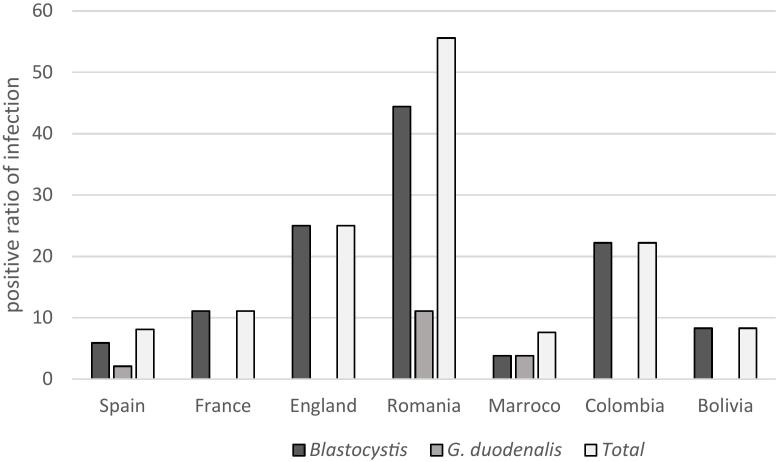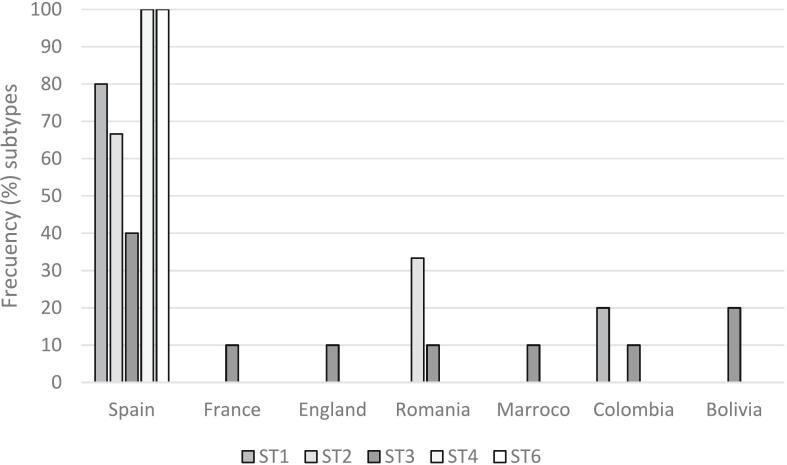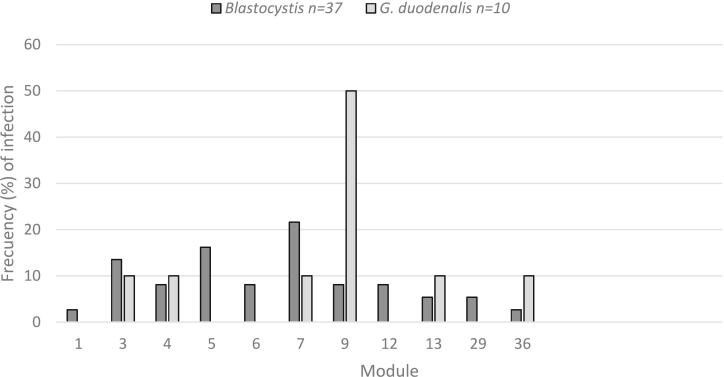Blastocystis and Giardia duodenalis infection in a male prison in Spain
IF 2.4
Q3 INFECTIOUS DISEASES
引用次数: 0
Abstract
Background
General conditions in a prison may facilitate water- or food-borne infections.
Methods
Detection of intestinal parasites was achieved in 471 male prison inmates by standard microscopic procedures on their stool samples. Positive samples were processed by PCR amplification of a 600-bp fragment of the Blastocystis SSU rRNA gene and partial sequences of the Giardia duodenalis bg genes. Identification of subtypes/genotypes was based on Sanger sequencing methods.
Results
Blastocystis was found in 7.9 % (37/471) and G. duodenalis was found in 2.1 % (10/471). Out of the 37 Blastocystis positive samples, 54 % (20/37) were successfully subtyped, allowing the identification of the subtypes ST3 (50 %), ST1 (25 %), ST2 (15 %), ST4 (5 %) and ST6 (5 %). Out of 10 G. duodenalis positive samples, 50 % (5/10) were successfully genotyped, allowing the identification of genotypes A (80 %) and B (20 %).
Conclusions
The predominance of ST3 within the prison inmates, together with its low intra-ST genetic variability, reflected inter-human transmission with spatial stability. The G. duodenalis distribution is not wide enough to consider the possibility of a generalized transmission via contaminated water or food. Personal hygiene practices among male prison inmates may be an important measure to prevent the transmission.



西班牙某男子监狱囊虫和十二指肠贾第鞭毛虫感染。
背景:监狱的一般条件可能促进水或食物传播的感染。方法:采用标准显微镜检查方法对471名男性监狱在押人员粪便标本进行肠道寄生虫检测。阳性标本采用PCR扩增囊虫SSU rRNA基因600 bp片段和十二指肠贾第虫bg基因部分序列。亚型/基因型鉴定采用Sanger测序法。结果:囊虫占7.9%(37/471),十二指肠棘球蚴占2.1%(10/471)。在37份囊虫阳性样本中,54%(20/37)成功分型,鉴定出ST3(50%)、ST1(25%)、ST2(15%)、ST4(5%)和ST6(5%)亚型。在10份阳性样本中,50%(5/10)成功分型,鉴定出基因型A(80%)和基因型B(20%)。结论:ST3在监狱囚犯中的优势,以及其较低的st内遗传变异性,反映了具有空间稳定性的人际传播。十二指肠螺杆菌分布范围不够广,不足以考虑通过受污染的水或食物进行广泛传播的可能性。男性监狱囚犯的个人卫生习惯可能是预防传播的重要措施。
本文章由计算机程序翻译,如有差异,请以英文原文为准。
求助全文
约1分钟内获得全文
求助全文
来源期刊

Parasite Epidemiology and Control
Medicine-Infectious Diseases
CiteScore
5.70
自引率
3.10%
发文量
44
审稿时长
17 weeks
期刊介绍:
Parasite Epidemiology and Control is an Open Access journal. There is an increasing amount of research in the parasitology area that analyses the patterns, causes, and effects of health and disease conditions in defined populations. This epidemiology of parasite infectious diseases is predominantly studied in human populations but also spans other major hosts of parasitic infections and as such this journal will have a broad remit. We will focus on the major areas of epidemiological study including disease etiology, disease surveillance, drug resistance and geographical spread and screening, biomonitoring, and comparisons of treatment effects in clinical trials for both human and other animals. We will also look at the epidemiology and control of vector insects. The journal will also cover the use of geographic information systems (Epi-GIS) for epidemiological surveillance which is a rapidly growing area of research in infectious diseases. Molecular epidemiological approaches are also particularly encouraged.
 求助内容:
求助内容: 应助结果提醒方式:
应助结果提醒方式:


